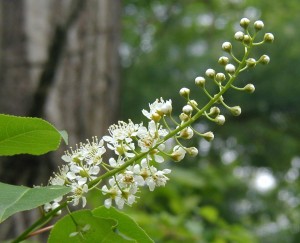
- Image by stephenccwu via Flickr
I’m wondering if the wild temperatures we had this spring affected the blooming time of our Black Cherry trees. We know that extremes in weather conditions will alter blooming times for many flowers and prohibit flowering altogether in some cases. Each year we wonder if the cherry blossoms will bloom during the Cherry Blossom Festival in Washington, DC.
2010 has been a wild roller coaster ride as far as temperatures go. We’ve had swings from 20 degrees above to 20 degrees below the average high temperatures. Surely, the blooming times of some plants were affected. A point in case is the Flowering Dogwood, Cornus florida. Its flowering was next to nil for 2010. Very few wild flowering dogwood trees bloomed in our immediate area. The same observations were seen as far away as Virginia, where the dogwoods did not bloom heavily as in previous years, if at all.
It’s easy to draw conclusions, but we really don’t know for sure what causes certain plants to really put on a show one year and barely be apparent the next. Without a proper study one can always find an alternate explanation. Perhaps the accumulation of necessary nutrients takes longer in some years affecting their reproductive cycles. Is that why we have bumper crops of acorns in some years and not so many in other years?
Last year was a great year for the Maple-Leaved Viburnum in our forest. They flowered most beautifully.
Certainly, temperature does have something to do with blooming times, at least for some plants, like cherries. By the way, the cherry blossoms in Washington were right on time for 2010 with a 10 day blooming period and a blooming peak on March 31.
At any rate it is interesting to see changes from year to year. Just observe the same plants over a several year period, you’ll be able to learn a lot from your little green friends.
2010 was a great flowering year for the wild cherry trees of the genus Prunus.
Saplings that are about an inch in diameter and about 12-15 feet tall, flowered the most this May that we have ever seen them. Perhaps these little trees just got big enough to flower that much. Maybe the rain and temperatures were optimal for flowering of the cherry trees in our locality. We can’t say with certainty what caused the exquisite blooming, but we can say it was a good blooming year for our little wild cherries.


We were lucky to see so many blossoms of wild cherry this year.


Two similar wild cherry trees grow in the same type of habitat at the edge of the woods or in recently cleared areas. To decide whether the flowering cherry trees we’re looking at are Black Cherry or Common Chokecherry, we need to look at the margins of the leaves. Are the teeth sharp or blunt? If the teeth are sharp, we have the Common Chokecherry, Prunus virginiana. If the teeth are blunt, we’re looking at the Black Cherry, Prunus serotina.
Consider the overall shape of the leaf. Is it elongated and pointed, or more squat with a short tip? Black cherry leaves are elongated, lance-like, and have 13 or more lateral leaf veins. Common chokecherry leaves have fewer leaf veins, 8 – 11, and are short-pointed at the tip.
To verify these identifications, note whether the fruits retain the calyx lobes (of the old sepals) at the top of the fruit next to the stem. If the cherry does not retain the calyx lobes, it is a common chokecherry. If the cherry retains the calyx lobes, it is a black cherry.
| Common Chokecherry | Black Cherry |
|---|---|
| leaves with sharp teeth | leaves with blunt teeth |
| leaf vein pairs 8-11 | leaf vein pairs 13+ |
| short pointed leaf tip | |
| fruit with no calyx | fruit retain calyx lobes |
Fruit from either tree is edible, if somewhat bitter. Grolier’s Field Guide to North American Trees tells us that every three or four years black cherry trees have a bumper crop of fruit. If the birds let you have enough, why not make some wild cherry jelly?
Our black cherries here are gaining size, but they’re still green. It seems that many of the flowers don’t produce fruit at all because of the few number that reach maturity. Has anyone seen a cluster of wild cherry fruit that was as long as the flower cluster? Typically, you’ll see two or three ripe berries for each cluster of a few dozen flowers.

The green cherries aren’t ready to eat of course, but you can see the retained calyx lobes at the top of the fruits, near the stem. Photo above taken 31 May 2010. Note the blunt teeth at the leaf margins and many side veins in the leaf, which indicate this to be a Black Cherry.
In reality you’ll probably never get enough wild cherries to make jelly. Besides many kinds of birds, raccoons, rabbits, squirrel, deer and bear will eat cherries. One of our black cherry trees didn’t bear any more fruit than three cherries on the whole tree, even though it flowered beautifully as seen in the first two images in this post.
I’m curious…does anyone out there use wild cherries for food or to make jelly?
Related articles by Zemanta
- Cherry Blossoms in Full Bloom (cbsnews.com)
- Map of ancient cherry trees to save traditional fruit from extinction (telegraph.co.uk)
![Reblog this post [with Zemanta]](http://img.zemanta.com/reblog_e.png?x-id=c52efeee-5e11-4f8a-9bcb-e3f9648efded)